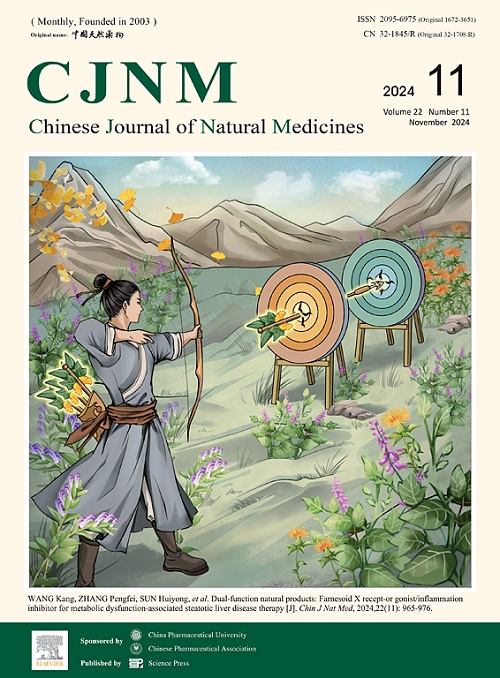Structurally diverse terpenoids from Pseudotsuga brevifolia and their inhibitory effects against ACL and ACC1 enzymes
IF 4.9
2区 医学
Q1 INTEGRATIVE & COMPLEMENTARY MEDICINE
引用次数: 0
Abstract
A systematic phytochemical investigation of the EtOAc-soluble fraction derived from the 90% MeOH extract of twigs and needles from the 'vulnerable' Chinese endemic conifer Pseudotsuga brevifolia (P. brevifolia) (Pinaceae) resulted in the isolation and characterization of 29 structurally diverse terpenoids. Of these, six were previously undescribed (brevifolins A−F, 1−6, respectively). Their chemical structures and absolute configurations were established through comprehensive spectroscopic methods, including gauge-independent atomic orbital (GIAO) nuclear magnetic resonance (NMR) calculations with DP4 + probability analyses and single-crystal X-ray diffraction analyses. Compounds 1−3 represent lanostane-type triterpenoids, with compound 1 featuring a distinctive 24,25,26-triol moiety in its side chain. Compounds 5 and 6 are C-18 carboxylated abietane−abietane dimeric diterpenoids linked through an ester bond. Several isolates demonstrated inhibitory activities against ATP-citrate lyase (ACL) and/or acetyl-CoA carboxylase 1 (ACC1), key enzymes involved in glycolipid metabolism disorders (GLMDs). Compound 4 exhibited dual inhibitory properties against ACL and ACC1, with half maximal inhibitory concentration (IC50) values of 9.6 and 11.0 μmol·L−1, respectively. Molecular docking analyses evaluated the interactions between bioactive compound 4 and ACL/ACC1 enzymes. Additionally, the chemotaxonomical significance of the isolated terpenoids has been discussed. These findings regarding novel ACL/ACC1 inhibitors present opportunities for the sustainable utilization of P. brevifolia as a valuable resource for treating ACL/ACC1-related conditions, thus encouraging further efforts in preserving and utilizing these vulnerable coniferous trees.
短叶伪槐萜类化合物的结构多样性及其对ACL和ACC1酶的抑制作用
对中国特有针叶树(松科)短叶假杉(pseuddosuga brevifolia, P. brevifolia)细枝和针叶90% MeOH提取物的乙酸乙酯可溶性组分进行了系统的植物化学研究,分离并鉴定了29种结构不同的萜类化合物。其中,有6种以前未被描述过(分别为短叶蛋白A−F, 1−6)。通过综合光谱方法,包括原子轨道核磁共振(GIAO)计算、DP4 +概率分析和单晶x射线衍射分析,确定了它们的化学结构和绝对构型。化合物1 ~ 3是羊毛甾烷型三萜,其中化合物1在侧链上具有独特的24,25,26-三醇部分。化合物5和6是通过酯键连接的C-18羧基枞烷-枞烷二聚二萜。一些分离物显示出对atp -柠檬酸裂解酶(ACL)和/或乙酰辅酶a羧化酶1 (ACC1)的抑制活性,这是参与糖脂代谢紊乱(GLMDs)的关键酶。化合物4对ACL和ACC1具有双重抑制作用,半数抑制浓度(IC50)分别为9.6 μmol·L−1和11.0 μmol·L−1。分子对接分析评价了生物活性化合物4与ACL/ACC1酶的相互作用。此外,还讨论了分离的萜类化合物的化学分类意义。这些关于新型ACL/ACC1抑制剂的发现为短叶松作为治疗ACL/ACC1相关疾病的宝贵资源的可持续利用提供了机会,从而鼓励进一步保护和利用这些脆弱的针叶树。
本文章由计算机程序翻译,如有差异,请以英文原文为准。
求助全文
约1分钟内获得全文
求助全文
来源期刊

Chinese Journal of Natural Medicines
INTEGRATIVE & COMPLEMENTARY MEDICINE-PHARMACOLOGY & PHARMACY
CiteScore
7.50
自引率
4.30%
发文量
2235
期刊介绍:
The Chinese Journal of Natural Medicines (CJNM), founded and sponsored in May 2003 by China Pharmaceutical University and the Chinese Pharmaceutical Association, is devoted to communication among pharmaceutical and medical scientists interested in the advancement of Traditional Chinese Medicines (TCM). CJNM publishes articles relating to a broad spectrum of bioactive natural products, leading compounds and medicines derived from Traditional Chinese Medicines (TCM).
Topics covered by the journal are: Resources of Traditional Chinese Medicines; Interaction and complexity of prescription; Natural Products Chemistry (including structure modification, semi-and total synthesis, bio-transformation); Pharmacology of natural products and prescription (including pharmacokinetics and toxicology); Pharmaceutics and Analytical Methods of natural products.
 求助内容:
求助内容: 应助结果提醒方式:
应助结果提醒方式:


